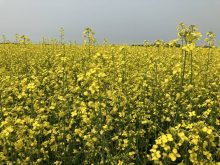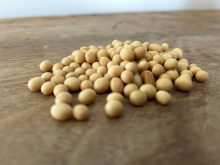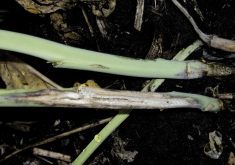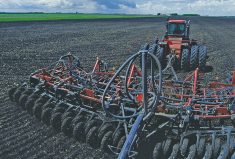A new hybrid canola cultivar that offers double resistance to clubroot has been registered and is now available to farmers.
Proven Seed PV 580 GC was developed by University of Alberta canola breeder Habibur Rahman and Crop Production Services (CPS).
It carries a resistance gene from Mendel, a European winter canola cultivar, and a second gene from an exotic germplasm. Researchers in its canola-breeding program, led by Rahman, began working on these genes in 2004 and studied more than 250 sources of resistance before determining the best two, the university said in a news release.
Read Also

Canola’s clubroot success story
At one time, scientists, agronomists and growers were extremely worried clubroot would spread across the Prairies and devastate Canada’s canola industry.
They worked on the resistance sources separately at first, locating the resistance genes in the chromosomes and developing separate individual canola lines based on the resistance of each source.
“With our partners at Crop Production Services, we then combined them to create this hybrid,” Rahman said in the release.
All previous clubroot-resistant cultivars offered single resistance.
The variety, which also has good blackleg resistance, will be available in areas where clubroot is already a problem in Alberta, primarily in the north-central area around Edmonton.
“Being the first year, we will always be limited in seed volumes,” Bruce Harrison, CPS’s director of research, development and innovation, said in an email.
Growers in central and north-central areas of Alberta should contact a CPS retailer in their area to find out about availability, he said.
But Harrison also warned that the new variety is not a silver bullet for clubroot.
“We are encouraging growers to focus on proper stewardship, including equipment sanitation and lengthening crop rotations,” he said. “We caution growers that PV 580 GC is a valuable tool, but should be utilized as part of an integrated and sustainable strategy to protect against this disease.”
Since clubroot was discovered in Alberta in 2003, nine new strains of the disease that can overcome current resistant lines have been found in the province, the university noted in its release. That includes a variety developed in 2009, which had its resistance overcome in just four years.
“It’s a nightmare that it broke down so fast,” Alberta Canola Producers Commission general manager Ward Toma said in 2014. “And it broke down so fast because it was not used properly, from what we understand.”
‘Multigenic’ resistance — meaning it has two genes with resistance — is important because, in most fields, there isn’t just one strain of clubroot, Canola Council of Canada agronomist Dan Orchard said in November when it was first announced PV 580 GC would be available this spring.
But with so many unclassified strains of clubroot — including newly discovered highly virulent clubroot pathotypes referred to as 5X — present in the Canadian Prairies, this new variety won’t protect against them all, he said.
“It’s just the tip of the iceberg with the discovery of these strains that haven’t been classified yet,” said Orchard, adding there are “many variations of 5X.”
“I wouldn’t want to call it a saviour for all the strains out there that we haven’t classified. We don’t know that yet because these strains are popping up as we speak.”
He said growers need to aggressively scout their canola fields for clubroot.
The Natural Sciences and Engineering Research Council of Canada funded Rahman’s research as did the Alberta Canola Producers Commission.
“This is exactly what we were looking for when we initially invested in Dr. Rahman’s work over 10 years ago,” said Daryl Tuck, who farms near Vegreville and is chair of ACPC’s research committee.















